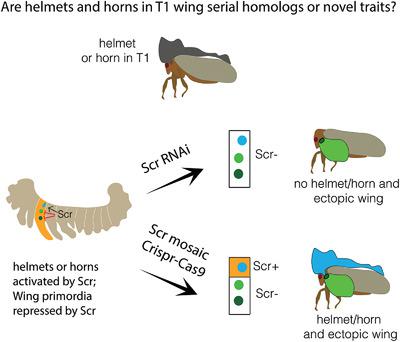Our official English website, www.x-mol.net, welcomes your
feedback! (Note: you will need to create a separate account there.)
Distinguishing serial homologs from novel traits: Experimental limitations and ideas for improvements
BioEssays ( IF 3.2 ) Pub Date : 2020-10-29 , DOI: 10.1002/bies.202000162 Antónia Monteiro 1, 2
BioEssays ( IF 3.2 ) Pub Date : 2020-10-29 , DOI: 10.1002/bies.202000162 Antónia Monteiro 1, 2
Affiliation

|
One of the central but yet unresolved problems in evolutionary biology concerns the origin of novel complex traits. One hypothesis is that complex traits derive from pre‐existing gene regulatory networks (GRNs) reused and modified to specify a novel trait somewhere else in the body. This simple explanation encounters problems when the novel trait that emerges in a body is in a region that is known to harbor a latent or repressed trait that has been silent for millions of years. Is the novel trait merely a re‐emerged de‐repressed trait or a truly novel trait that emerged via a novel deployment of an old GRN? A couple of new studies sided on opposite sides of this question when investigating the origin of horns in dung beetles and helmets in treehoppers that develop in the first thoracic segment (T1) of their bodies, a segment known to harbor a pair of repressed/modified wings in close relatives. Here, I point to some key limitations of the experimental approaches used and highlight additional experiments that could be done in future to resolve the developmental origin of these and other traits.
中文翻译:

区分序列同系物与新特征:实验限制和改进思路
进化生物学中一个核心但尚未解决的问题涉及新的复杂特征的起源。一种假设是,复杂性状源自预先存在的基因调控网络 (GRN),这些网络被重复使用和修改以指定身体其他部位的新性状。当身体中出现的新特征位于已知隐藏了数百万年的潜伏或压抑特征的区域时,这种简单的解释就会遇到问题。新特征仅仅是重新出现的去压抑特征,还是通过旧 GRN 的新部署而出现的真正新特征?在调查蜣螂的角的起源和在身体的第一个胸段 (T1) 发育的树蝉的头盔时,一些新的研究站在了这个问题的对立面,已知在近亲中含有一对抑制/修饰的翅膀的部分。在这里,我指出了所使用的实验方法的一些关键局限性,并强调了将来可以进行的其他实验,以解决这些和其他特征的发育起源。
更新日期:2020-12-22
中文翻译:

区分序列同系物与新特征:实验限制和改进思路
进化生物学中一个核心但尚未解决的问题涉及新的复杂特征的起源。一种假设是,复杂性状源自预先存在的基因调控网络 (GRN),这些网络被重复使用和修改以指定身体其他部位的新性状。当身体中出现的新特征位于已知隐藏了数百万年的潜伏或压抑特征的区域时,这种简单的解释就会遇到问题。新特征仅仅是重新出现的去压抑特征,还是通过旧 GRN 的新部署而出现的真正新特征?在调查蜣螂的角的起源和在身体的第一个胸段 (T1) 发育的树蝉的头盔时,一些新的研究站在了这个问题的对立面,已知在近亲中含有一对抑制/修饰的翅膀的部分。在这里,我指出了所使用的实验方法的一些关键局限性,并强调了将来可以进行的其他实验,以解决这些和其他特征的发育起源。











































 京公网安备 11010802027423号
京公网安备 11010802027423号